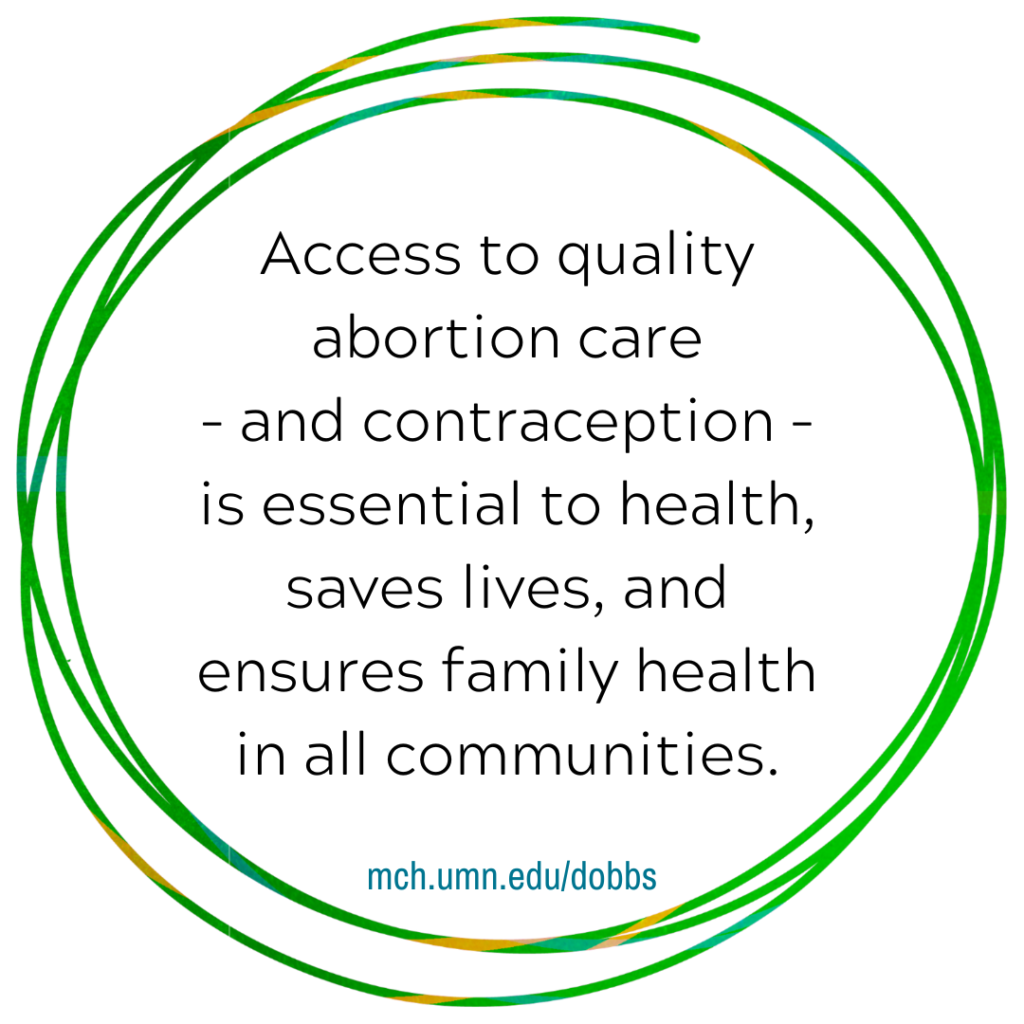The Supreme Court’s final majority decision on June 24, 2022, overturning federal rights to abortion, is a direct injury to the health and wellbeing of families, communities, and our society. It will lead to adverse pregnancy outcomes, including increased rates of infant and maternal mortality (Grossman & Jacobowitz, 1981; Pabayo et al., 2020; Hoyert, 2020; Stevenson, 2021). It will have damaging effects on the health of women and all birthing persons, irrespective of political, religious, or cultural beliefs. In addition, the Dobbs decision will increase already existing inequities in access to quality health services and reproductive freedom (Barber et al., 2019; Kozhimannil et al., 2019; March of Dimes, 2020; Krieger et al., 2020), particularly among communities of color (Manian, 2014).
Access to quality abortion care – and contraception – is essential to health, saves lives, and ensures family health in all communities.
As public health and Maternal and Child Health (MCH) professionals, we are called to promote and protect the health of all MCH populations, advocate for health equity, and respond to community health needs at this historical moment. We have the ethical responsibility to uphold the principles of “beneficence, nonmaleficence, truthfulness, justice, and respect for autonomy (emphasis added) that underlie professional conduct within community, health care, and public health settings” (US DHHS, 2018).
The Maternal and Child Health Program and the Center for Leadership Education in Maternal and Child Public Health at the University of Minnesota School of Public Health stand in solidarity with individuals, families, and communities affected by the Dobbs decision and stand steadfastly with members of our society who this affront will harm the most: Black, Indigenous, and People of Color (BIPOC) women; women living in rural communities; women and families living in poverty; and members of the Lesbian, Gay, Bisexual, Transgender, and Queer (LGBTQ) community. Furthermore, we support all judicial and legislative actions to protect women’s autonomy and all individuals affected by the Supreme Court’s decision.
Find resources to learn more, educate others, support our community partners, and advocate to build, rebuild, and restore policies, programs, and systems that ensure access to abortion services.
References
- Barber, J. S., Ela, E., Gatny, H., Kusunoki, Y., Fakih, S., Batra, P., & Farris, K. (2019). Contraceptive Desert? Black-White Differences in Characteristics of Nearby Pharmacies. Journal of racial and ethnic health disparities, 6(4), 719–732. https://doi.org/10.1007/s40615-019-00570-3
- Grossman, M., Jacobowitz, S. Variations in infant mortality rates among counties of the United States: The roles of public policies and programs. Demography 18, 695–713 (1981). https://doi.org/10.2307/2060956
- Hoyert DL. Maternal mortality rates in the United States, 2020. NCHS Health E-Stats. 2022. DOI: https://dx.doi.org/10.15620/cdc:113967
- Kozhimannil, K. B., Interrante, J. D., Henning-Smith, C., & Admon, L. K. (2019). Rural-Urban Differences In Severe Maternal Morbidity And Mortality In The US, 2007-15. Health affairs (Project Hope), 38(12), 2077–2085. https://doi.org/10.1377/hlthaff.2019.00805
- Krieger, N., Van Wye, G., Huynh, M., Waterman, P. D., Maduro, G., Li, W., & Bassett, M. T. (2020). Structural racism, historical redlining, and risk of preterm birth in New York City, 2013–2017. American journal of public health, 110(7), 1046-1053.
- Manian, M. (2014). The consequences of abortion restrictions for women’s healthcare. Wash. & Lee L. Rev., 71, 1317.
- March of Dimes. (2020). Nowhere to go: Maternity Care Deserts Across the U.S. 2020 Report. March of Dimes. https://www.marchofdimes.org/materials/2020-Maternity-Care-Report.pdf
- Pabayo, R., Ehntholt, A., Cook, D. M., Reynolds, M., Muennig, P., & Liu, S. Y. (2020). Laws Restricting Access to Abortion Services and Infant Mortality Risk in the United States. International journal of environmental research and public health, 17(11), 3773. https://doi.org/10.3390/ijerph17113773
- Stevenson A. J. (2021). The Pregnancy-Related Mortality Impact of a Total Abortion Ban in the United States: A Research Note on Increased Deaths Due to Remaining Pregnant. Demography, 58(6), 2019–2028. https://doi.org/10.1215/00703370-9585908
- U.S. Department of Health and Human Services, Health Resources and Services Administration, Maternal and Child Health Bureau. (2018). Maternal and Child Health Leadership Competencies. Rockville, Maryland: U.S. Department of Health and Human Services.
